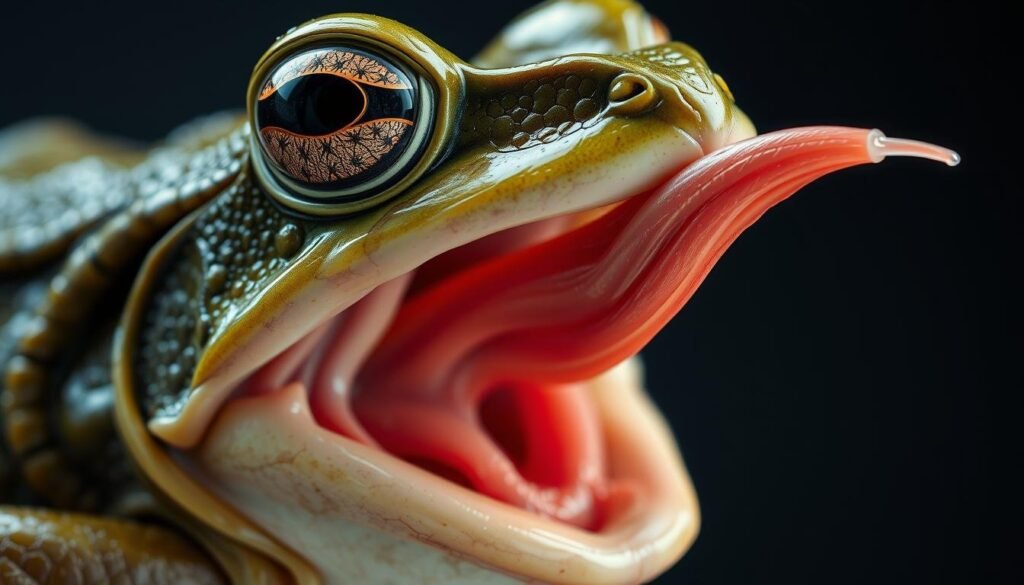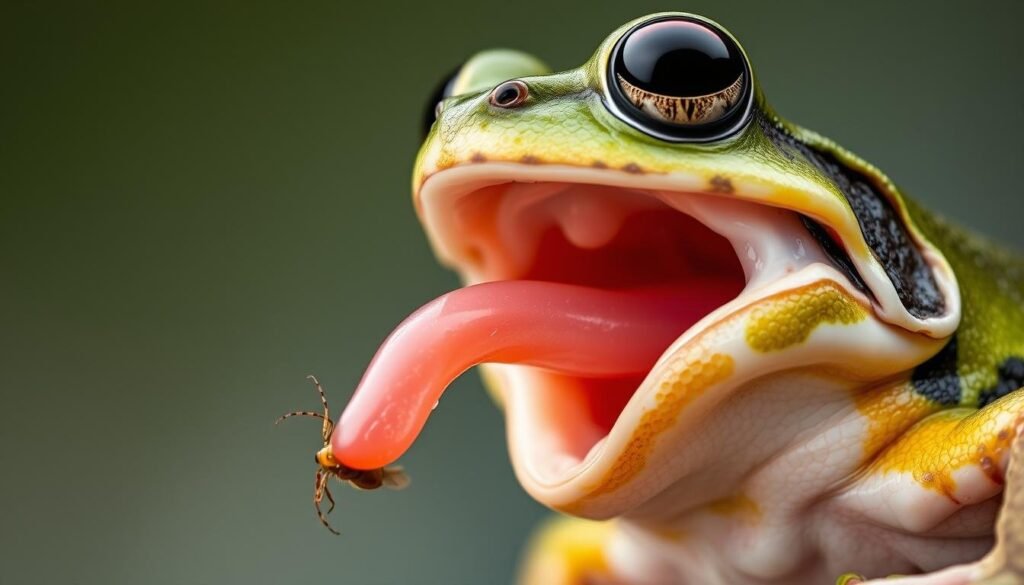Why Frogs Use Their Tongues to Catch Insects? Have you ever seen a frog catch a fly in a split second? It’s amazing how they do it. The frog tongue mechanism is a key part of their success. It shows how frogs have adapted to their world.
Frogs are experts at catching insects with their tongues. Their tongues are long and strong, perfect for catching prey. This skill is at the heart of their amphibian feeding habits.
Learning about the frog tongue mechanism reveals a lot. It shows how their body, physics, and biology work together. This teamwork makes their feeding behavior truly impressive.
Contents
- 1 The Remarkable Feeding Mechanism of Frogs
- 2 Why Do Frogs Extend Tongues to Catch Insects?
- 3 The Anatomy of a Frog’s Tongue
- 4 The Physics Behind the Frog’s Tongue Action
- 5 Variations in Tongue Mechanisms Across Frog Species
- 6 Recent Scientific Discoveries About Frog Tongues
- 7 How Frogs’ Tongues Compare to Other Animals’ Feeding Methods
- 8 Conclusion: Why Frogs Use Their Tongues to Catch Insects?
- 9 FAQ
- 9.1 How do frogs use their tongues to catch insects?
- 9.2 What is the anatomy of a frog’s tongue?
- 9.3 Why do frogs have sticky tongues?
- 9.4 How fast can a frog extend its tongue?
- 9.5 Do all frog species use their tongues to catch prey?
- 9.6 What are some recent scientific discoveries about frog tongues?
- 9.7 How do frog tongues compare to other animals’ feeding methods?
- 9.8 Can frogs control the stickiness of their tongues?
The Remarkable Feeding Mechanism of Frogs
Frogs have a unique way of catching insects with their tongues. Their tongues are key to their survival. They have a special adaptation of frog tongues that helps them catch prey accurately.
The process involves several key steps:
- Identifying prey using their keen eyesight
- Rapidly extending their tongues to catch the prey
- Retracting their tongues back into their mouths with the prey
This amazing feeding mechanism is thanks to the tongue anatomy of frogs. Their tongues are both strong and sticky.
Frogs’ quick and efficient catching of prey shows their evolutionary adaptations. Learning about the adaptation of frog tongues helps us understand their feeding and survival strategies.
Why Do Frogs Extend Tongues to Catch Insects?
Frogs catching insects with their tongues is fascinating. It’s not just interesting; it’s also key to their survival.
The way a frog’s tongue works is crucial for catching insects. They can shoot out their tongues fast, often in milliseconds. This quick action is helped by sticky mucus on the tongue, making it easier to catch prey.
Survival and Efficiency in Hunting
Catching insects quickly is essential for frogs. By using their tongues, they can grab prey from a distance. This saves energy and keeps them safe from predators.
Frogs are very good at this. They can aim their tongue based on the insect’s movement and distance. This shows their amazing precision.
Frogs extending their tongues to catch insects shows their adaptability. It’s a complex process that involves their tongue’s physical traits and a smart hunting strategy.
Learning about how frogs catch insects helps us understand their biology and ecology. It shows why we need to protect these amazing creatures and their homes.
The Anatomy of a Frog’s Tongue
Frogs have a special tongue that helps them eat. Their tongue is key to catching prey quickly and efficiently.
The tongue muscles in frogs are complex. They work together to extend and retract the tongue. This lets frogs catch insects from far away.
The tongue is also sticky. It has mucus that helps catch insects. This stickiness is vital for frogs to eat.
The tongue of a frog has several important parts. Here’s a table that explains them:
| Component | Description | Function |
|---|---|---|
| Muscular Structure | Complex arrangement of muscles | Enables tongue extension and retraction |
| Mucus Coverage | Sticky surface | Ensures prey capture |
| Tongue Length | Variable, depending on species | Affects prey capture distance |
Learning about a frog’s tongue shows how amazing these creatures are. Their tongues are a big part of how they survive. It’s fascinating to see how their tongues help them eat.
The Physics Behind the Frog’s Tongue Action
Frogs can catch insects with their tongues in a cool way. Thephysics of frog tongueis complex. It lets frogs shoot their tongues fast.
Thefrog tongue mechanismuses muscles and bones in a special way. When a frog gets ready to catch something, it tightens certain muscles. This builds up energy in the tongue’s elastic parts.

Then, when the frog lets go, the energy shoots the tongue out. The tongue has sticky mucus to help catch prey.
When the frog pulls its tongue back, it’s just as quick. This lets the frog grab and eat its prey fast.
Learning about thephysics of frog tongueshows how amazing frogs are. It also teaches us about the science behind how they eat. By studying thefrog tongue mechanism, we can appreciate nature’s clever designs even more.
Variations in Tongue Mechanisms Across Frog Species
Frog species have evolved different tongue mechanisms. Each is suited to their environment and prey. This shows how adaptable frogs are and how they thrive in many ecosystems.
The adaptation of frog tongues is key to their feeding. Each species has unique tongues and ways to catch prey. Some have sticky tongues, while others can shoot their tongues fast.
These differences aren’t just in tongue shape. They also affect how frogs catch prey. Some frogs use a ‘ballistic’ method, shooting their tongue out and then pulling it back in with prey. This is great for catching quick insects.
The amphibian feeding habits of frogs are tied to their tongues. The variety in feeding habits shows how adaptable frogs are. By studying these differences, scientists learn about the evolution of frog feeding behaviors.
Looking at frog tongue variations shows the complexity of their feeding. It also highlights the need to protect these diverse species.
Recent Scientific Discoveries About Frog Tongues
Recent studies have uncovered the amazing physics behind frog tongues. Scientists have been exploring how frogs catch insects with their tongues. They’ve found some really cool insights into how this works.
The frog tongue mechanism is more than just a simple movement. It’s a complex process that involves quick extension and retraction. Some frogs can stretch their tongues up to 1.5 times their body length in just milliseconds.
The table below summarizes some key findings related to the physics behind frog tongues:
| Aspect | Description | Significance |
|---|---|---|
| Tongue Extension Speed | Up to 1.5 times body length in milliseconds | Enables catching of fast-moving insects |
| Adhesive Properties | Specialized mucus on the tongue | Enhances prey capture efficiency |
| Biomechanical Forces | Rapid acceleration and deceleration forces | Influences the evolution of tongue structure |
These findings show how adaptable frogs are and how they catch prey. Learning about the physics of frog tongue helps us understand their biology. It also inspires new ideas for technology.
As scientists keep studying, we’ll learn even more about frog tongues. This will help us appreciate these amazing creatures even more.
How Frogs’ Tongues Compare to Other Animals’ Feeding Methods
In the animal kingdom, how creatures catch their food is very different. The frog’s tongue is a great example of how animals adapt. It shows how frogs catch insects in a unique way.
Frogs can catch prey fast and accurately with their tongues. This is different from spiders and birds. Frogs can shoot their tongues out quickly, making them good at catching insects.
When we compare frogs to chameleons, we see both similarities and differences. Both have sticky tongues, but how they use them is different. This shows how animals have evolved different ways to eat.
Looking at how animals eat helps us understand how frogs’ tongues work. It also shows us the variety of ways animals can catch food. This makes us appreciate the complexity of nature’s feeding strategies.
Conclusion: Why Frogs Use Their Tongues to Catch Insects?
You now know how frogs catch insects with their tongues. Their tongue anatomy and feeding habits are truly fascinating.
The frog’s tongue is made for catching prey quickly. It can extend and retract fast. This action involves complex physics, like speed and force.
Looking at different frog species shows how their tongues work. This helps us understand their biology and adaptability. Studying frog tongues and feeding habits is interesting and shows how adaptable they are.
See Also: Owls Rotate Their Heads Almost Fully – Here’s Why
FAQ
How do frogs use their tongues to catch insects?
Frogs catch insects by extending their tongues quickly. Their tongues are covered in sticky mucus. When they pull their tongues back, they bring the insect with them.
What is the anatomy of a frog’s tongue?
A frog’s tongue is a muscular organ at the front of their mouth. It has sticky mucus to catch prey. The tongue’s muscles work together for fast extension and retraction.
Why do frogs have sticky tongues?
Frogs have sticky tongues to catch and hold prey. This makes feeding easier, especially for fast insects.
How fast can a frog extend its tongue?
Some frogs can extend their tongues up to 6 meters per second. This makes their tongue movements among the fastest in animals.
Do all frog species use their tongues to catch prey?
Most frogs use their tongues to catch prey. But, some species have evolved different ways to eat. Still, most frogs rely on their tongues.
What are some recent scientific discoveries about frog tongues?
Recent studies have uncovered how frog tongues work. They’ve also found new frog species with special tongue features.
How do frog tongues compare to other animals’ feeding methods?
Frog tongues are unique for their fast extension and retraction. This makes them very efficient. Other animals, like chameleons, have fast tongues too, but frog tongues work differently.
Can frogs control the stickiness of their tongues?
Some research suggests frogs can adjust their tongue’s stickiness. They might change it based on the prey they catch.

Zyair Larson, based in Denver, Colorado, has over 12 years of experience studying animal behavior. He has worked with the World Wildlife Fund (WWF) and National Geographic, researching wildlife and sharing insights on animal habits globally.

